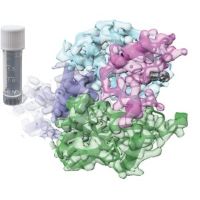Specification
| Description | Recombinant protein from the full-length sequence of Homo sapiens N-acyl phosphatidylethanolamine phospholipase D (NAPEPLD), transcript variant 2 (NM_198990). |
| Organism | Homo sapiens (Human) |
| Expression Host | Human Cells |
| Tag Info | His or DYKDDDDK. Please contact us if you need further information or require specific designed tag. |
| Purity | Greater than 90% by SDS-PAGE gel |
| Uniprot ID | Q6IQ20 |
| Entry Name | NAPEP_HUMAN |
| Gene Names | NAPEPLD C7orf18 |
| Alternative Gene Names | C7orf18 |
| Alternative Protein Names | N-acyl-phosphatidylethanolamine-hydrolyzing phospholipase D (N-acyl phosphatidylethanolamine phospholipase D) (NAPE-PLD) (NAPE-hydrolyzing phospholipase D) (EC 3.1.4.54) |
| Application | Antigens, Western, ELISA and other in vitro binding or in vivo functional assays, and protein-protein interaction studies; For research & development use only! |
| Buffer | Purified protein formulated in a sterile solution of PBS buffer, pH7.2, without any preservatives |
| Endotoxin | Endotoxin level is < 0.1 ng/µg of protein (<1EU /µg) |
| Length | 393 |
| Molecular Weight(Da) | 45596 |
| Protein Sequence | (The sequence of expressed protein may have some variation from the sequence shown below. Please contact us for the exact sequence.) MDENESNQSLMTSSQYPKEAVRKRQNSARNSGASDSSRFSRKSFKLDYRLEEDVTKSKKGKDGRFVNPWPTWKNPSIPNVLRWLIMEKDHSSVPSSKEELDKELPVLKPYFITNPEEAGVREAGLRVTWLGHATVMVEMDELIFLTDPIFSSRASPSQYMGPKRFRRSPCTISELPPIDAVLISHNHYDHLDYNSVIALNERFGNELRWFVPLGLLDWMQKCGCENVIELDWWEENCVPGHDKVTFVFTPSQHWCKRTLMDDNKVLWGSWSVLGPWNRFFFAGDTGYCPAFEEIGKRFGPFDLAAIPIGAYEPRWFMKYQHVDPEEAVRIHTDVQTKKSMAIHWGTFALANEHYLEPPVKLNEALERYGLNAEDFFVLKHGESRYLNNDDENF |
Background
| Function | FUNCTION: D-type phospholipase that hydrolyzes N-acyl-phosphatidylethanolamines (NAPEs) to produce bioactive N-acylethanolamines/fatty acid ethanolamides (NAEs/FAEs) and phosphatidic acid (PubMed:14634025, PubMed:16527816, PubMed:27571266, PubMed:25684574). Cleaves the terminal phosphodiester bond of diacyl- and alkenylacyl-NAPEs, primarily playing a role in the generation of long-chain saturated and monounsaturated NAEs in the brain (By similarity). May control NAPE homeostasis in dopaminergic neuron membranes and regulate neuron survival, partly through RAC1 activation (By similarity). As a regulator of lipid metabolism in the adipose tissue, mediates the crosstalk between adipocytes, gut microbiota and immune cells to control body temperature and weight. In particular, regulates energy homeostasis by promoting cold-induced brown or beige adipocyte differentiation program to generate heat from fatty acids and glucose. Has limited D-type phospholipase activity toward N-acyl lyso-NAPEs (By similarity). {ECO:0000250|UniProtKB:Q8BH82, ECO:0000269|PubMed:14634025, ECO:0000269|PubMed:16527816, ECO:0000269|PubMed:25684574, ECO:0000269|PubMed:27571266}. |
| Pathway | |
| Protein Families | NAPE-PLD family |
| Tissue Specificity | Widely expressed. Highest expression in brain, kidney and testis (at protein level). Expressed in adipose tissue (at protein level). {ECO:0000250|UniProtKB:Q8BH82}. |
QC Data
| Note | Please contact us for QC Data |
| Product Image (Reference Only) |  |

